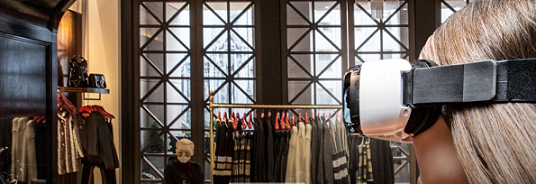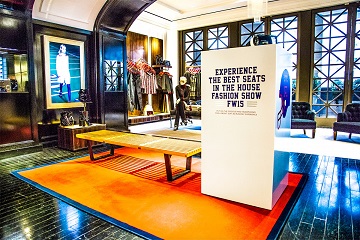
With 2016 set to be a tipping point for virtual reality, we look at early implications for retail.
2016 is the year Oculus Rift and Sony’s PlayStationVR finally hit the stores, and retailers are already flirting with incorporating virtual reality experiences into their branding and shopping experiences.
In 2015, outdoor sportswear company The North Face experimented with Google Cardboard, creating immersive films set amid natural scenes in the American West. Luxury boutique The Apartment has used Samsung Gear VR to give shoppers a view into its signature brick-and-mortar space from anywhere in the world. And in New York, Tommy Hilfiger’s Fifth Avenue store has installed Samsung Gear VR headsets, immersing shoppers in a virtual journey to view and shop the label’s fall fashion show.
 While virtual reality remains a niche technology used mostly by enthusiasts, many observers expect this to change quickly. The number of active VR users is forecast to reach 171 million by 2018, according to a 2015 Statista survey. With this in mind, brands are seeking to use VR both for direct sales opportunities and to enrich the consumer’s experience of the brand.
While virtual reality remains a niche technology used mostly by enthusiasts, many observers expect this to change quickly. The number of active VR users is forecast to reach 171 million by 2018, according to a 2015 Statista survey. With this in mind, brands are seeking to use VR both for direct sales opportunities and to enrich the consumer’s experience of the brand.
The hospitality industry is also taking note. At the end of October, Shangri-La Hotels announced the introduction of Samsung Gear VR headsets across all global sales offices. The hotel group have produced immersive VR videos for over a quarter of their 94 hotels and resorts, with plans to complete the set by mid-2016. Example videos include exploring the presidential suite of Shangri-La Hotel, Tokyo and seeing the views from Beijing’s tallest building, Shangri-La’s China World Summit Wing.
“We want to employ innovative technology in a way that is meaningful to our trade partners and beneficial to consumers,” Steven Taylor, chief marketing officer of Shangri-La International Hotel Management Ltd, said in a statement. “Not only will Shangri-La’s immersive 360-degree videos provide travel experts a better understanding of the Shangri-La product and experience, but there are many creative applications. For example, a travel planner could virtually walk a CEO through Island Shangri-La, Hong Kong’s ballroom prior to a big product announcement or use it to heighten clients’ anticipation for an upcoming trip.”
Source: jwtintelligence


